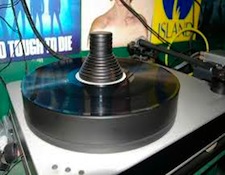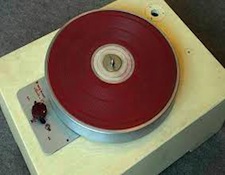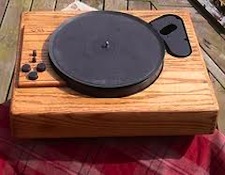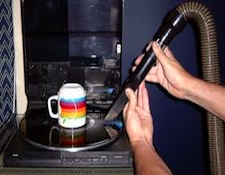It’s the time of year for saving money!
Back in the old days, before the 1980s, I used to think that the reason you might want to use a record clamp was to keep the record from slipping on the platter as a result of drag produced by pulling the stylus through the groove.
 That might actually have been true in the OLD, old days, when people used crystal cartridges with removable “needles” (Genuine Osmium, for example — good for as many as several plays, or genuine cactus needles good for just one). Back then, the platters were usually puck-drive “flocked” sheet metal stampings; and tracking forces nearing the greater part of an OUNCE [28.4 grams] weren’t at all unheard-of. As a matter of fact, in those days, when a record was particularly warped, one of the things we did to be able to still play it was to put a penny (2.5 grams) or even a nickel (5.0 grams) on top of the headshell, so there might very well have been enough weight to cause some drag-induced slippage.
That might actually have been true in the OLD, old days, when people used crystal cartridges with removable “needles” (Genuine Osmium, for example — good for as many as several plays, or genuine cactus needles good for just one). Back then, the platters were usually puck-drive “flocked” sheet metal stampings; and tracking forces nearing the greater part of an OUNCE [28.4 grams] weren’t at all unheard-of. As a matter of fact, in those days, when a record was particularly warped, one of the things we did to be able to still play it was to put a penny (2.5 grams) or even a nickel (5.0 grams) on top of the headshell, so there might very well have been enough weight to cause some drag-induced slippage.
For most modern turntables, though, and for modern high-compliance cartridges with a MAXIMUM recommended tracking force in the range of 3 grams, and (for at least many) the ability to track at a force of as little as 1 to 1 ½ grams, the idea of needing to compensate for stylus drag seems absurd. On the other hand…
 In their quest for (check as many as apply) __ performance; __ beauty; __ uniqueness; __ marketing advantage; __ something else, entirely; a number of modern turntable designers have abandoned the convention of the platter having a full-contact, single-disc shape of about the same size as the records it’s intended to play, and have gone, instead, to any number of variants, ranging from a single center support-disc of about the same size as the record’s label, to multiple disc-or-other-shaped supporting parts holding the record (essentially) in the air, with more or less actual physical contact. The mass of the rotating assembly (the platter or platter-equivalent) has also varied wildly, from the extreme low mass of the old Weathers™ ‘table to the seeming excesses of the Gray™ turntable and others even more massive. The point here is that — for some of the lightest, weirdest, or least-physical-contact designs — drag may, indeed be a factor, as it might even be for conventional-looking, high-contact-area ‘tables that use a more-or- less-slippery surface (vinyl, acrylic, bare aluminum, ceramic, etc.) for the disc to rest on.
In their quest for (check as many as apply) __ performance; __ beauty; __ uniqueness; __ marketing advantage; __ something else, entirely; a number of modern turntable designers have abandoned the convention of the platter having a full-contact, single-disc shape of about the same size as the records it’s intended to play, and have gone, instead, to any number of variants, ranging from a single center support-disc of about the same size as the record’s label, to multiple disc-or-other-shaped supporting parts holding the record (essentially) in the air, with more or less actual physical contact. The mass of the rotating assembly (the platter or platter-equivalent) has also varied wildly, from the extreme low mass of the old Weathers™ ‘table to the seeming excesses of the Gray™ turntable and others even more massive. The point here is that — for some of the lightest, weirdest, or least-physical-contact designs — drag may, indeed be a factor, as it might even be for conventional-looking, high-contact-area ‘tables that use a more-or- less-slippery surface (vinyl, acrylic, bare aluminum, ceramic, etc.) for the disc to rest on.
For slippage, there are really only three possible solutions: Either make the platter’s surface “non-slip”; use a vacuum system or some kind of a weight or clamp to hold the record in place; or both.
Since time immemorial, cutting ‘tables have used a second, off-center hole in the cutting “blank” and a matching lock-pin on the platter to prevent unwanted slippage. The first actual non-slip device for a consumer turntable, though, was probably the good ol’ fashion’ rubber mat that better record players have been equipped with for almost as long as there have been disc records.
 Back in the days when I was a kid, we fervently believed (as Julian Hirsch and other “experts” had told us) that the only parts of a system that actually affected its sound were the phono cartridge and the speaker (Remember that this all started even before stereo came along). Because of that, we thought that that ordinary ridged rubber mat that came with the turntable (red, on my Rek-O-Kut L34, and grey, on my later Rek-O-Kut B12H) was just fine and was all that was necessary. In fact, when, after a long hiatus, I dropped back into audiophilia in the 1980s, I was surprised – and frankly disbelieving – when people told me that the thick, “squishy”, Platter Matter™ turntable mat that was popular at the time would make an audible difference. It did, of course – a quite significant one — and that, possibly more than anything else, got me and others to thinking about just exactly what was happening at the point where the stylus meets the groove.
Back in the days when I was a kid, we fervently believed (as Julian Hirsch and other “experts” had told us) that the only parts of a system that actually affected its sound were the phono cartridge and the speaker (Remember that this all started even before stereo came along). Because of that, we thought that that ordinary ridged rubber mat that came with the turntable (red, on my Rek-O-Kut L34, and grey, on my later Rek-O-Kut B12H) was just fine and was all that was necessary. In fact, when, after a long hiatus, I dropped back into audiophilia in the 1980s, I was surprised – and frankly disbelieving – when people told me that the thick, “squishy”, Platter Matter™ turntable mat that was popular at the time would make an audible difference. It did, of course – a quite significant one — and that, possibly more than anything else, got me and others to thinking about just exactly what was happening at the point where the stylus meets the groove.
At that time, there was all kinds of everything from wild-eyed conjecture to learned discourse about Newton and the idea that “for every action, there’s an equal and opposite reaction.” “If the groove is wiggling the stylus,” people thought, “must not the stylus also be wiggling the groove? And if there’s that kind of energy transfer going on back-and-forth, what kind of an effect is it having on the sound?”
]]> One of the most obvious energy-transfer effects had to do with resonance: If you stimulate (apply physical energy to) any object whatsoever, it will have a tendency to “ring” at its fundamental resonant frequency. That’s any object at all and any stimulus at all (including dragging a rock through a groove), and the amplitude of the resonant effect will be directly related to the force of the stimulus and (if it’s periodic) the closeness of the frequency of the stimulus to the frequency of the object’s fundamental resonance: The closer they are, the louder the “ring”.
One of the most obvious energy-transfer effects had to do with resonance: If you stimulate (apply physical energy to) any object whatsoever, it will have a tendency to “ring” at its fundamental resonant frequency. That’s any object at all and any stimulus at all (including dragging a rock through a groove), and the amplitude of the resonant effect will be directly related to the force of the stimulus and (if it’s periodic) the closeness of the frequency of the stimulus to the frequency of the object’s fundamental resonance: The closer they are, the louder the “ring”.
Adding mass to the resonating object will lower the frequency of its fundamental resonance and, if the frequency of stimulus remains the same, lower resonant amplitude, too – both good things in a record playback system – and both things that can be accomplished by a good heavy platter mat or record clamp. (One thing to understand, however, is that a “screw-down” type of clamp, if it’s not heavy, may not be of much value at all, and ANY clamp can, if a “dished” record is being played and the dished side is up, actually make things worse by forcing the outer part of the disc to rise away from the platter, lessening whatever damping or resonance-lowering effects the mass of the platter might otherwise have offered).
 A vacuum hold-down system is probably the best thing possible for coupling the disc to the platter and both positioning it and lowering its effective resonant frequency and amplitude. Obviously, though, a vacuum hold-down system can’t be added as an aftermarket accessory – your turntable either already has one or it doesn’t!
A vacuum hold-down system is probably the best thing possible for coupling the disc to the platter and both positioning it and lowering its effective resonant frequency and amplitude. Obviously, though, a vacuum hold-down system can’t be added as an aftermarket accessory – your turntable either already has one or it doesn’t!
If it doesn’t, that could actually be a good thing: Much of the speed stability of any turntable (its freedom from “wow and flutter”) comes from the inertia of the total rotating system which is derived, in part, from the combined mass of the platter, the disc, and whatever mat you may be using. With a vacuum hold-down system, no mat can be used, so that whole element of the equation goes away, and what could be – with a light-weight platter — a significant contributor to speed stability could be lost.
 If greater speed stability is your goal, go with the heavyweight platter mat instead of the record clamp. Even if both weigh exactly the same, the platter mat’s greater diameter will give it considerably greater effective angular momentum, and give you a lot more of the speed stability you’re looking for.
If greater speed stability is your goal, go with the heavyweight platter mat instead of the record clamp. Even if both weigh exactly the same, the platter mat’s greater diameter will give it considerably greater effective angular momentum, and give you a lot more of the speed stability you’re looking for.
In any case, though, always choose your platter mat or record clamp carefully. Some may really improve the sound of your system; some – if they’re not well-designed or aren’t a good match to your ‘table – can actually make your system sound worse; and some may just look cool, “tech-y”, or exotic; cost a lot of money; and do nothing at all!





